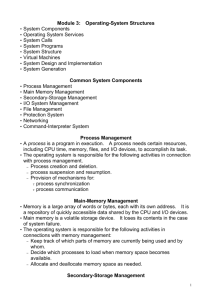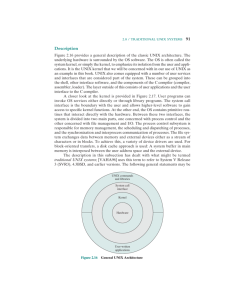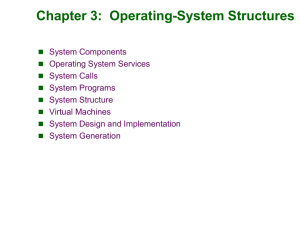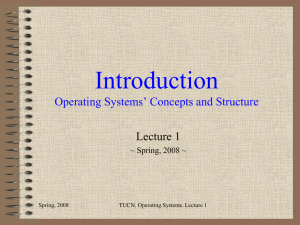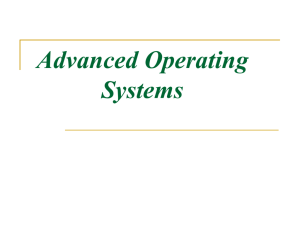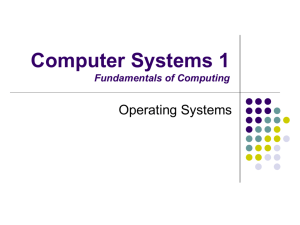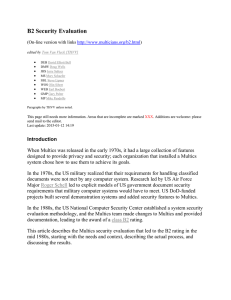lec2
advertisement
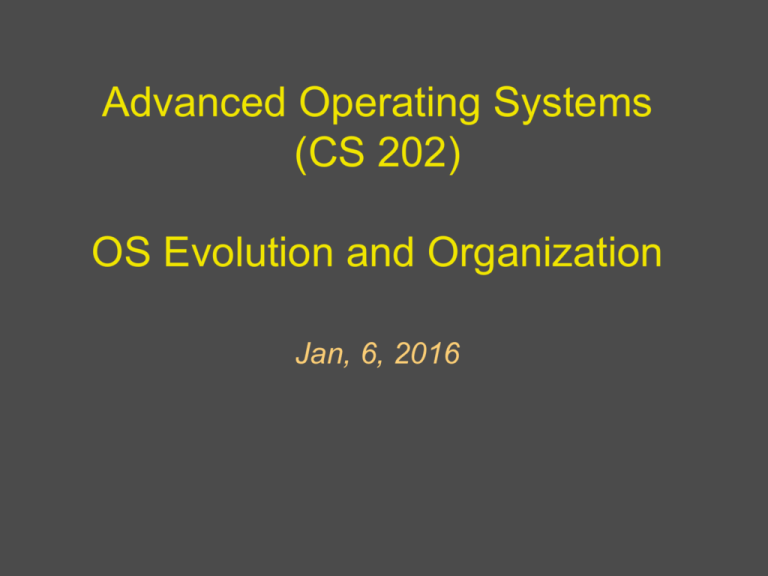
Advanced Operating Systems (CS 202) OS Evolution and Organization Jan, 6, 2016 Coming up • Reading for next week: – Finish unix paper – For Monday, Spin and Exokernel – Wednesday, L4 – Links on class website • Programming assignment released Monday 2 Today • Evolution of Operating Systems (and computers!) – Some slides modified from Silberschatz and Gavin, as well as Margo Seltzer • Operating Systems models 3 Dawn of computing program CPU printer • Pre 1950 : the very first electronic computers – valves and relays – single program with dedicated function • Pre 1960 : stored program valve machines – single job at a time; OS is a program loader 4 Phase 0 of OS Evolution (40s to 1955) • No OS – Computers are exotic, expensive, large, slow experimental equipment – Program in machine language and using plugboards – User sits at console: no overlap between computation, I/O, user thinking, etc.. • • Program manually via card decks Goal: number crunching for missile computations 5 OS progress in this period • People developed libraries of routines that are common – Including those to talk to I/O devices – Punch cards (enabling copying/exchange of these libraries) a big advance! – Pre-cursor to OS 6 Phase 1: 1955-1970 • Computers expensive; people cheap Use computers efficiently – move people away from machine – OS becomes a batch monitor – • • • Loads a job, runs it, then moves on to next If a program fails, OS records memory contents somewhere More efficient use of hardware but increasingly difficult to debug 7 • Batch systems on mainframe computers – – collections of jobs made up into a batch example: IBM 1401/7094 • – card decks spooled onto magnetic tape and from tape to printer example: English Electric Leo KDF9 32K 48-bit words, 2sec cycle time • punched paper-tape input ‘walk-up’ service or spooling via mag tape • 8 Advances in technology in this stage • Data channels and interrupts – Allow overlap of I/O and computing – Buffering and interrupt handling done by OS – Spool (buffer) jobs onto “high speed” drums 9 Phase 1, problems • Utilization is low (one job at a time) • No protection between jobs – But one job at a time, so? • Short jobs wait behind long jobs • Coordinating concurrent activities 10 Advances in OS in this period • Hardware provided memory support • • • • (protection and relocation) Multiprogramming (not to be confused with time sharing) Scheduling: let short jobs run first OS must manage interactions between concurrent things OS/360 from IBM first OS designed to run on a family of machines from small to large 11 Some important projects • Atlas computer/OS from Manchester U. (late 50s/early 60s) – First recognizable OS – Separate address space for kernel – Early virtual memory • THE Multiprogramming system (early 60s) – – Introduced semaphores Attempt at proving systems correct; interesting software engineering insights 12 Not all is smooth • Operating systems didn’t really work • OS/360 introduced in 1963 but did not really work until 1968 – Reported on in mythical man month • Extremely complicated systems – 5-7 years development time typical – Written in assembly, with no structured programming – Birth of software engineering? 13 Phase 2: 1970s • Computers and people are expensive – Help people be more productive – Interactive time sharing: let many people use the same machine at the same time – Emergence of minicomputers • Terminals are cheap – Keep data online on fancy file systems – Attempt to provide reasonable response times (Avoid thrashing) 14 Important advances and systems • Compatible Time-Sharing System (CTSS) – – – – – MIT project (demonstrated in 1961) One of the first time sharing systems Corbato won Turing award in 1990 Pioneered much of the work in scheduling Motivated MULTICS 15 MULTICS • Jointly developed by MIT, Bell Labs and GE • Envisioned one main computer to support everyone – People use computing like a utility service just like electricity – sound familiar? • Many many fundamental ideas: protection rings, • • hierarchical file systems, devices as files, … Building it was more difficult than expected Technology caught up 16 Unix appears • Ken Thompson, who worked on MULTICS, wanted to • • use an old PDP-7 laying around in Bell labs He and Dennis Richie built a system designed by programmers for programmers Originally in assembly. Rewritten in C – – If you notice for the paper, they are defending this decision However, this is a new and important advance: portable operating systems! • Shared code with everyone (particularly universities) 17 Unix (cont’d) • Berkeley added support for virtual memory for the VAX • DARPA selected Unix as its networking platform in arpanet • Unix became commercial – …which eventually lead Linus Torvald to develop Linux 18 Some important ideas in Unix • OS written in a high level language • OS portable across hardware platforms – Computing is no longer a pipe stove/vertical system • Pipes • Mountable file systems • Many more (we’ll talk about unix later) 19 Phase 3: 1980s • Computers are cheap, people expensive – Put a computer in each terminal – CP/M from DEC first personal computer OS (for 8080/85) processors – IBM needed software for their PCs, but CP/M was behind schedule – Approached Bill Gates to see if he can build one – Gates approached Seattle computer products, bought 86DOS and created MS-DOS – Goal: finish quickly and run existing CP/M software – OS becomes subroutine library and command executive 20 New technologies in Phase 3 • Personal workstations – The PERQ – Xerox Alto – SUN workstation • Personal computers – Apple II – IBM PC – Macintosh 21 New technologies (cont’d) • Business applications! – Word processors – Spreadsheets – Databases • Marketplace is broken up horizontally – Hardware – OS – Applications 22 New advances in OS • PC OS was a regression for OS – Stepped back to primitive phase 1 style OS leaving the cool developments that occurred in phase 2 • Academia was still active, and some developments still occurred in mainframe and workstation space 23 Phase 4: Networked systems 1990s to now? • Its all about connectivity • We want to share data not hardware • Networked applications drive everything – Web, email, messaging, social networks, … • Protection and multiprogramming less important for personal machines – But more important for servers 24 Phase 4, continued • Market place continued horizontal stratification – – – ISPs (service between OS and applications) Information is a commodity Advertising a new marketplace • New network based architectures – – – – Clusters Grids Distributed operating systems Cloud computing (or is that phase 5?) 25 New problems • Large scale – Google file system, mapreduce, … • Concurrency at large scale – ACID (Atomicity, Consistency, Isolation and Durability) in Internet Scale systems • • Very large delays Partitioning • Security and Privacy 26 Phase 5 • New generation? • Computing evolving beyond networked systems – But what is it? – …and what problems will it bring? 27 OS STRUCTURE 28 OS Structure • What does OS structure refer to? • The way the OS software is organized with respect to the applications it serves and the hardware that it manages so that it can meet its goals 29 Lets start with the basic idea • All OS’s use “Controlled Direct Execution” – User programs when scheduled run directly on the CPU – They don’t have to ask permission to use memory – its virtualized or partitioned somehow (with hardware help) • OS is a sleeping beauty – Gets woken up by events – Enough for time sharing? 30 Events • An event is an “unnatural” change in control flow – – Events immediately stop current execution Changes mode, context (machine state), or both • The kernel defines a handler for each event type – – Event handlers typically execute in kernel mode The specific types of events are defined by the machine • Once the system is booted, all entry to the kernel occurs as the result of an event 31 Categorizing Events • Two kinds of events: synchronous and asynchronous • Sync events are caused by executing instructions – Example? • Async events are caused by an external event – Example? Asynchronous events CPU ticks Synchronous events 32 33 OS Structure • We saw that the OS arbitrates and abstracts the hardware and provides services to applications – What are example services? – Process and thread management; memory management; IPC; file systems; access to devices including network • How should it be structured? – Why does it matter? What are the goals? 34 OS structure choices • OS has to run in privileged mode sometimes – But does everything run in privileged mode? • If the application could benefit from custom operation, can we provide that? – Does that come at the cost of performance or safety? • Can the OS adapt operation to available resources? 35 Why is the structure of an OS important? • Protection – User from user and system from user • Performance – Does the structure facilitate good performance? • Flexibility/Extensibility – Can we adapt the OS to the application • Scalability – Performance goes up with more resources • Agility – Adapt to application needs and resources • Responsiveness – How quickly it reacts to external events • Can it meet these requirements? 36 Can the goals be achieved together? • How do modern operating systems meet these goals? They can’t (perfectly) meet all – Some conflict with each other – For example, performance and protection – • Lets look at the major models 37 Monolithic Kernel Applications OS Services and Device drivers Hardware, managed by OS 38 DOS Like Structure Applications OS Services and Device drivers What is the difference? Hardware, managed by OS 39 DOS vs. Monolithic • Loss of protection in DOS-like structure unacceptable for general purpose OS • Monolithic structure provides protection – Reduces performance loss by consolidation • – What causes performance loss? But prevents opportunity of customizing the OS • Is that important? YES! 40 Extensibility/customization • Applications are very different; consider video • game vs. a number crunching application Lets consider a concrete application – – Page fault occurs OS action? • • • Find a free frame (page replacement policy) Update page table Resume process • Providing extensibility was a big area of research 41 Micro-kernel Applications File System Memory manager CPU scheduler Micro-kernel Hardware, managed by OS 42 Discussion of microkernels • Performance loss! – A lot of boarder crossings – Separate address spaces – expensive • – Explicit and implicit costs (memory hierarchy) Lets compare a system call for monolithic vs. micro-kernel • What are the advantages? 43 Next time: Extensible OS structures • DOS-like structure: – good performance and extensibility – Bad protection • Monolithic kernels: – Good performance and protection – Bad extensibility • Microkernels – Good protection and extensibility – Bad performance! 44

